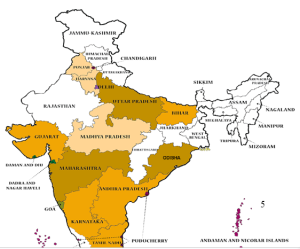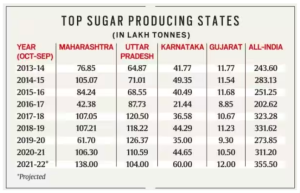Context:
In 2021-2022, India surpassed Brazil to become the world’s largest sugar producer, reaching an all-time high production of 359 lakh tonnes.

- The achievement is marred by concerns over the sustainability of the sugar industry due to dwindling resources.
About Sugarcane Crop:
- Sugarcane is a giant tropical grass from the family Graminaceae, whose stalk has the particular capacity to store a crystallizable sugar, sucrose.
- It is the main source of sugar, Gur (jaggery), khandsari and molasses.
- Top Sugarcane Producing States: Uttar Pradesh, Maharashtra, Karnataka, Tamil Nadu, Bihar.
Suitable Conditions for sugarcane Production:
- Temperature: Between 21-27°C with hot and humid climate.
- Rainfall: Around 75-100 cm.
- Soil Type: Deep rich loamy soil.
|
Enroll now for UPSC Online Course
Status of Sugarcane Sector in India:

- The Largest Sugarcane Producer: India has emerged as the largest producer of sugarcane in the world, surpassing Brazil during the 2021-22.
- The Second Largest Sugar Exporter: India has consistently been the second-largest exporter of sugar, following Brazil.
The excess sugar production in India can be attributed to several factors:
- Domestic Demand: India is the world’s largest consumer of sugar, necessitating high production levels to meet its huge domestic demand.
- Fair and Remunerative Price (FRP) Scheme: The Central government’s FRP scheme mandates a minimum price that sugar mills must pay to sugarcane farmers.
- This policy ensures that farmers receive fair profits for their crops, making sugarcane cultivation an attractive and profitable option for them.
- State Government Subsidies: State governments offer significant subsidies to incentivize sugarcane cultivation.
- Higher Exports: In 2021-2022, India exported a record 110 lakh tonnes of sugar, seeking to tap into international markets and capitalize on excess production.
| Determining Prices of Sugarcane: Central and State Governments
Central Government: Fair and Remunerative Price (FRP)
- The Central Government sets the Fair and Remunerative Price (FRP) for sugarcane.
- The FRP is recommended by the Commission for Agricultural Costs and Prices (CACP) and approved by the Cabinet Committee on Economic Affairs (CCEA).
- The FRP is based on the recommendations of the Rangarajan Committee report on reorganizing the sugarcane industry.
State Government: State Advised Prices (SAP)
- The State Government of key sugarcane-producing states announces the State Advised Prices (SAP).
- SAP is generally higher than the FRP set by the Central Government.
|
Advantages of Increasing Sugar Production:
- Generation of By-Products: Sugar production yields valuable by-products like molasses, bagasse, and press mud, which find applications in producing ethanol, paper, and bio-fertilizers, promoting resource efficiency.
- Ethanol Production and Fuel Blending: Sugar mills can divert excess sugarcane to produce ethanol, which serves as a green fuel. Blending ethanol with petrol reduces crude oil imports, saving foreign exchange.
- Government’s Blending Targets: India has set blending targets of 10% ethanol with petrol by 2022 and 20% by 2025 to promote eco-friendly fuel usage.
- Diversification and Increased Income: Cultivating sugarcane allows farmers to diversify their agricultural activities, providing an opportunity for additional income streams.
- Crop Integration and Diversification: Sugarcane cultivation can be integrated with other crops like vegetables, fruits, and spices, leading to improved soil health, reduced pest and disease pressure, and higher crop yields.
Efforts made by the government to address the issue of sugar surplus and promote the use of ethanol:
- Diverting Sugar Surplus to Ethanol Production: The government considered diverting excess sugar to produce ethanol, which has multiple industrial applications and reduces harmful emissions in the transport sector.
- Ethanol is the active ingredient in alcoholic beverages and is also used in the chemicals and cosmetics industries.
- Ethanol Blending Programme (EBP): The EBP, launched in 2003, aims to blend ethanol with petrol to lower crude oil imports and decrease greenhouse gas emissions.
- Early Achievement of Blending Target: India successfully achieved an average of 10% ethanol blending across the country five months ahead of the targeted deadline of November 2022, enhancing the use of green fuel.
- GST Reduction on Ethanol: In 2021, the government reduced the GST on ethanol from 18% to 5%, promoting its production and integration into the economy.
|
Enroll now for UPSC Online Classes
Excessive sugarcane cultivation impacts groundwater in several ways:
- High Water Consumption: Sugarcane is a resource-intensive cash crop that requires a large amount of water for its cultivation.
- In regions where rainfall is insufficient, sugarcane relies heavily on groundwater for irrigation.
- The top sugarcane-growing states in India face significant water scarcity.
- Non-Rechargeable Aquifers: Much of the groundwater used for sugarcane cultivation is found in confined aquifers, which are not easily recharged by rainfall, making it a finite and non-renewable resource.
- Large-Scale Water Usage: Producing 100 kg of sugar from one tonne of sugarcane can consume around 2 lakh liters of groundwater for irrigation alone. Additionally, water is needed for industrial sugar manufacturing and refining processes.
- Drought and Groundwater Stress: The top sugarcane-growing states are already prone to drought and face stress on their groundwater resources.
- The Central Ground Water Board (CGWB) reported that a significant portion of its groundwater assessment units in Maharashtra, Uttar Pradesh, and Karnataka were classified as ‘semi-critical,’ ‘critical,’ or ‘over-exploited.’
- Environmental Concerns: Excessive groundwater extraction for sugarcane cultivation can lead to environmental issues such as land subsidence, saltwater intrusion, and the drying up of wells and water bodies.
What needs to be done to address the challenges of excessive sugarcane cultivation and its impact on groundwater:
- Correcting Incentives: Assess and modify existing subsidy schemes that favor sugarcane over other crops. Introduce fair and comprehensive subsidies for a variety of crops to encourage diversification, even distribution of cultivation, and equitable income for farmers.
- Promoting Sustainable Practices: Encourage environmentally responsible sugarcane cultivation practices, such as drip irrigation.
- Drip irrigation reduces sugarcane water consumption by up to 70% compared to flood irrigation.
- Investing in Water-saving Systems: Implement water-saving and management systems like rainwater harvesting, wastewater treatment, and canal irrigation networks to reduce stress on groundwater reserves and utilize alternative water sources for irrigation.
- Enhancing Groundwater Research: Invest in groundwater research to better understand its availability, distribution, and sustainable management. Improved data and mapping can inform better decision-making and resource allocation.
- Prioritizing Sustainability: As India advances in the agricultural sector, prioritize sustainability by integrating eco-friendly practices, promoting crop diversification, and minimizing the strain on natural resources.
| Water Intensive Cropping Pattern in India:
Cropping patterns are shifting towards water-intensive crops due to:
- Policy Incentives: Subsidies for electricity, canal water, and water-intensive crops encourage farmers to cultivate them.
- Guaranteed Procurement: Stable yields and minimum support price (MSP) for water-intensive crops attract farmers.
- Unpredictable Market Prices: Alternative crops have fluctuating profitability, making them riskier.
To promote crop diversification, the government should:
- Frame stable price policies with sufficient procurement.
- Focus on technological development for alternative crops.
- Implement controlled irrigation practices.
- Promote rainwater harvesting and improve rural infrastructure.
|
News Source: The Hindu
![]() 5 Aug 2023
5 Aug 2023


